
Hangeul is the Korean alphabet that people use to read and write in Korean. Some people misunderstand that King Sejong created Korean, but this is not true. Korean people spoke in Korean since a long time ago. However, they could not read and write because they did not have their own lettering system. Therefore, King Sejong created Hangeul, and now, every person in Korea can read and write with Hangeul. These days, the world also knows the excellence of Hangeul. Many foreigners are learning Hangeul and it is also used to design clothes, goods, and so on. To celebrate Hangeul Day on October 9th, let's find out more about Hangeul!
● Where Did Hangeul Come From?
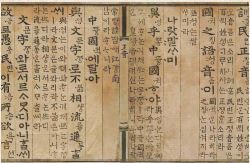
Hangeul is a unique lettering system created and used by Korean people. There is definite information on the Hangeul alphabet that reveals when it was made and who made it. In 1443, King Sejong the Great of the Joseon Dynasty created Hangeul and proclaimed it in 1446 in the name of "Hunminjeongeum," which means the proper sounds for educating people. Before the creation of Hangeul, Koreans used Hanja, which are Chinese characters, when writing. Chinese characters were so difficult and complicated that many people, except for some intellectuals, could not learn. King Sejong the Great considered this point and explained why he created "Hunminjeongeum" through this preface. "As the speech of this country is different from that of China, it does not match the Chinese letters. Therefore, even if the commoners want to communicate, many of them in the end cannot state their concerns. Saddened by this, I made 28 letters newly. It is my wish that all the people may easily learn these letters and that they be convenient for daily use." This shows how much King Sejong loved the people.
● Let's See What It Means!

Today's Hangeul consists of 14 consonants and ten vowels. The vowels of Hangeul were created based on the principle of yin and yang. According to the Hunminjeongeum Haerye version, there are 'ㆍ, ㅡ, ㅣ' as basic vowels. 'ㆍ' was modeled on heaven, which is yang, and 'ㅡ' is modeled on the earth, which is yin. 'ㅣ' is modeled after the human shape, which is an intermediate thing between yin and yang. Heaven, earth, and humans originated from the myth of Dangun, and these are the major elements that compose the universe. Other vowels such as 'ㅏ,ㅑ,ㅓ,ㅕ,ㅗ,ㅛ,ㅜ,ㅠ' are combinations of 'ㆍ, ㅡ, and ㅣ'.
The basic consonants 'ㄱ,ㄴ,ㅁ,ㅅ,ㅇ' are modeled after vocal organs. Moreover, these are related to the bearings, the seasons, and the five elements which are metal, wood, water, fire and earth. 'ㄱ' is a molar sound and it stands for spring. 'ㄴ', 'ㅁ', 'ㅅ', 'ㅇ' are sounds from the tongue, lips, teeth, and throat, and each of these means summer, late summer, autumn, and winter, respectively. Other consonants were made through adding strokes to these basic consonants.
● Invincible Hangeul Day
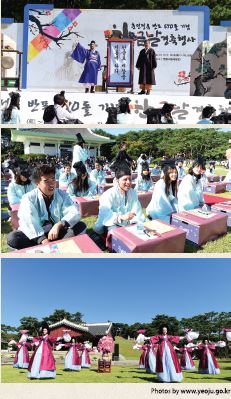
Today's Hangeul Day is October 9th on the solar calendar. On September 29th on the lunar calendar, the Joseon Language Research Association of Nationalist Korean linguists became the main initiator and held a memorial ceremony for the 480th anniversary of the creation of "Hunminjeongeum". This day was designated as the 1st "Gagya day," and it was renamed into Hangeul Day in 1928. After gaining independence in 1945, the fact that Hangeul had been proclaimed for the first ten days of September was found out. They decided on the date of September 10th on the lunar calendar, which is the end of the first ten days, and changed it over to the solar calendar. It is today's Hangeul Day, October 9th. Hangeul Day was designated as a national holiday in 1946 and had a big celebration every year. However, in 1990, many holidays including Hangeul Day were treated as an obstacle to industrial development, so they were excluded from legal holidays and became a simple anniversary. In 2005, "The Designation Act of Hangeul Day to National Day" was passed at the National Assembly of the Republic of Korea plenary session. Later, Hangeul Day became holiday again in 2013 with consideration for the international status of Hangeul and the demands of the people. To increase the awareness of love for Hangeul, the government is promoting the originality and science of Hangeul through campaigns in Korea and abroad. A Hangeul Day celebration event is held every year. Since 2008, Hangeul Week has been designated and a celebration period has been set for one week before and after Hangeul Day on October 9th. Every year the government has organized various events such as exhibitions, performances, and academic conferences on various new topics.
● The King Sejong Award

Hangeul was designated as a UNESCO World Heritage and "Hunminjeongeum", which contains the preface and the creation principles of Hangeul, was designated as National Treasure No.70. Moreover, it was registered as a UNESCO Memory of the World in October 1997. In addition, the King Sejong Award is the UNESCO prize that is given to a person or group of people with a big contribution to society for eliminating illiteracy every year. Then, why is the prize called the King Sejong Award? First, the motivation for the invention of "Hunminjeongeum" was to eliminate illiteracy. Second, King Sejong contributed to eliminating the illiteracy of the people through the creation of Hangeul, which is easy to learn and use.
● Hangeul Steps So Far

Nowadays, the language of the ethnic minority people is disappearing. The ethnic minorities of the world, such as the Cia-Cia of Indonesia and the Nana of Russia, had difficulty in expressing their traditional languages by using the Roman alphabet and the Russian alphabet. If they could not represent the sounds, they could not write them down. If they could not write them down, the language of the ethnic minorities would be increasingly extinct. Several domestic institutions connected with the research of Hangeul and "Hunminjeongeum" are trying to help the crisis of minorities. Hangeul is optimized to represent all the sounds of letters and the world is in need of Hangeul more than we thought. With this in mind, Departments of Korean Studies and Korean Language have opened in universities worldwide. According to Korean Studies Net, there are 312 Departments of Koreans Studies and 147 Centers of Korean Studies in 66 regions and countries around the world. In particular, according to the statistics of the Ministry of Education of the People's Republic of China in 2012, there are 244 universities which have Departments of Korean Studies because they were interested in Korean language, traditionally due to geographical reasons. Similarly, the number of the Test of Proficiency in Korean test takers has been increasing. From the first test in 1997 until the most recent test in 2017, the number of test takers has increased 70 times.
● Hangeul Is an Art
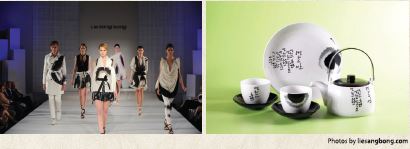
Hangeul is also used for artistic purposes, not just than literary purposes. Korean designer Lee Sang-bong opened a fashion show with a design that combined Korean with clothes and attracted world-wide attention. Hangeul is used not only in the design of clothes, but also in the design of various goods such as furniture, dishes, and even mobile phones and mobile phone cases. In addition, recently famous Korean actor Yoo Ah-in created a collaboration of Hangeul and English that anyone can understand. This means that Hangeul looks unique and stylish and is available as a design element.
● Circles and Squares Are Real Letters
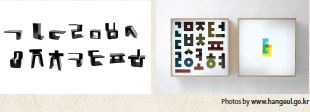
For those who do not know Hangeul, Hangeul characters appear to be geometric figures. For them, "ㅇ" or "ㅁ" is a circle, a square, "ㅣ" and " ㅡ " is just a straight line. For foreigners who do not know Korean language, it is astonishing that circles and squares are real letters. The participants of popular JTBC’s talk-variety show "Non-Summit" talked about this theme in their 16th episode. The important fact was mentioned that Hangeul is easier to learn and foreigners can read Hangeul in a short period of time compared to other characters. In fact, there are foreigners who master Hangeul in 2~3 hours. In addition, it is worthwhile to see that there are a lot of cases in which even if a mother does not teach a child Hangeul, the child can understand Hangeul by tying the sound that comes out of mother's mouth and the picture written in the fairy tale book. Through this, we can know that Hangeul is a language that anyone can easily learn.
● You Can Participate at CBNU!
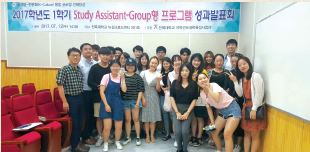
CBNU holds a Korean speech contest and an exhibition of illustrated poems for international students. In recent years, CBNU held an international students festival and had a Korean quiz contest instead of a Korean speech contest. On October 12th of this year, the international students festival and Korean quiz contest will be held. If you are interested in Korean and Hangeul, participate in this!
Moreover, there is a useful program at CBNU, Study Assistant. When international students bring their tasks and theses, Korean students will help them to correct the grammar or misspelled words. In addition, they can also give them a little assistance to study liberal arts. If you need their help, visit the Center for International Student Services on the third floor of the New Silk Road Center from 10 a.m. to 5 p.m.
● Misunderstandings and Facts about Hangeul
1. Hangeul was not included in the UNESCO Memory-of-the-World Program; it was the book named "Hunminjeongeum".
2. The UNESCO Memory-of-the-World Program is about the object of registration, not the contents of the record.
3. Actual Hangeul cannot express the pronunciation of all languages. In addition, the present Hangeul has fewer pronunciations than "Hunminjeongeum" at the time of creation.
4. The saying “Hangeul is a unique lettering system to express all sounds” is not a linguistic proposition, but a philosophical expression based on the idea that all sounds are composed of five basic harmonies at the time of creation.
5. Hangeul is not the name of the Korean language. It is the name of Korean letters.
6. The name "Hunminjeongeum" and its abbreviation "Jeongeum" were also the original names of the letters at the time of creation.
7. Hangeul was not adopted as an official language of the Cia-Cia tribe. They just used Hangeul for writing the Cia-Cia language.
English science historian John Man said, "Korean Hangeul is the long-awaited perfect script." As he said, Hangeul is a very scientific, convenient, and unique alphabet system that can be learned easily. Nowadays, the world understands the excellence of Hangeul. How glorious! From now on, let's cherish and love our beautiful lettering, Hangeul, rathering than overusing slang or shortened words too much.
Choi Jee-min, Editor-in-Chief, Shermamatova Aizharkyn & Meimankulova Nazbiike, Reporters

